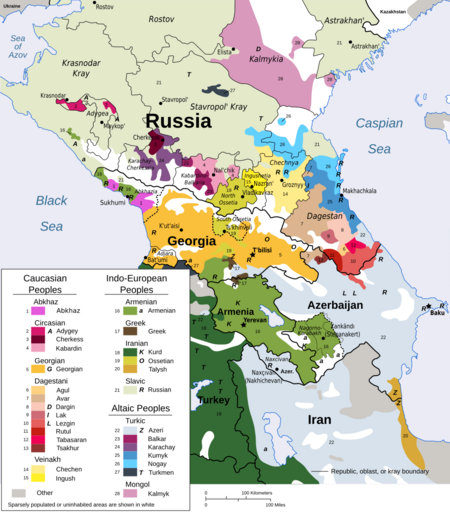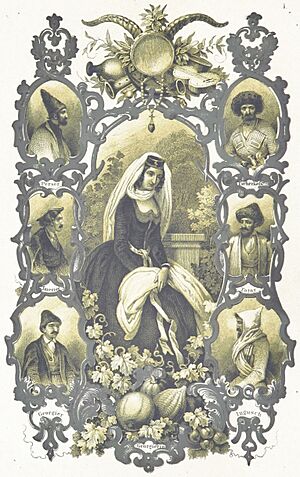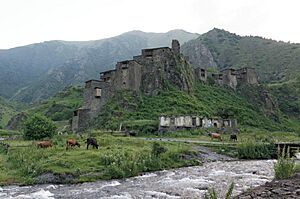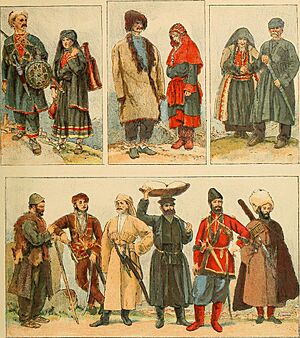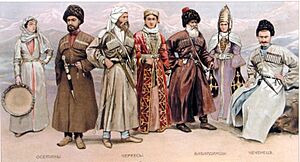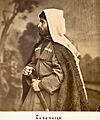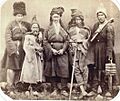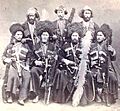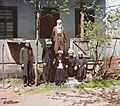Ethnic groups in the Caucasus facts for kids
The peoples of the Caucasus are many different ethnic groups living in the Caucasus region. This area is between the Black Sea and the Caspian Sea. More than 50 different groups call this place home.
Contents
Language Groups
The people of the Caucasus speak many different languages. These languages can be grouped into families. Some language families are native to the Caucasus. Others came from different parts of the world.
Native Caucasian Languages
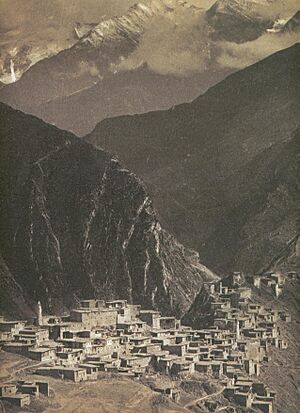
People who speak languages native to the Caucasus are usually put into three main groups: Kartvelian, Northeast Caucasian, and Northwest Caucasian.
- Georgians (the largest group)
- Ingiloys
- Zans (like Lazs and Mingrelians)
- Svans
Northeast Caucasian languages
- Avar–Andic peoples:
- Avars (a large group)
- Andis
- Tindis
- Dargins
- Laks
- Lezgic peoples:
- Lezgins (a large group)
- Aguls
- Rutuls
- Nakh peoples:
- Chechens (a very large group)
- Ingush
Northwest Caucasian languages
- Abazins
- Abkhazians
- Circassians (a very large group, many live outside the Caucasus)
- Kabardians (a large group)
The Georgians are the only Caucasian people with their own independent country, Georgia. Other groups like the Chechens, Avars, Lezgins, and Kabardians live in republics within Russia. Many Circassians live in other countries like Turkey and Jordan.
Indo-European Languages
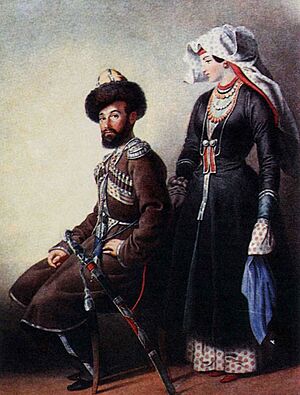
Many Caucasians speak languages from the Indo-European family.
- Armenians (many live in Armenia and other countries)
- Caucasus Greeks
- Iranian group:
- Ossetians (live in North Ossetia–Alania in Russia and South Ossetia)
- Talysh
- Tats
- Kurds
- Yazidis (live in Armenia and Georgia)
- Slavic group:
Armenians are a large group, with many living in their home country of Armenia. However, even more Armenians live in other countries around the world. Ossetians live in two main areas: one in Russia and one that is disputed with Georgia. Russians mostly live in the northern parts of the Caucasus.
Semitic Languages
Some Caucasians speak languages from the Semitic family.
- Assyrians: About 35,000 Assyrians live in the Caucasus. They are Eastern Rite Christians and speak Eastern Aramaic dialects. They originally came from Mesopotamia.
- Caucasus Jews: These include Mountain Jews and Georgian Jews. Many have moved to Israel or the United States.
- Arabs in the Caucasus: Some people with Arab roots live here, though many have mixed with other groups.
Mongolic Languages
- Kalmyks: These are western Mongols who moved to Russia in 1607. Today, they are the main group in Kalmykia, which is a republic on the western side of the Caspian Sea. Kalmykia is special because it has Europe's only Buddhist government.
Turkic Languages
Many Caucasians speak languages from the Turkic family.
- Kipchaks:
- Kumyks
- Balkars
- Karachays
- Nogais
- Oghuz Turks:
- Azerbaijanis (the largest Turkic group in the Caucasus)
- Meskhetian Turks
The Azerbaijanis are the largest Turkic-speaking group in the Caucasus. Most of them live in the country of Azerbaijan. Other Turkic groups like the Karachays and Balkars live in their own republics within Russia.
Genetic History
The different language groups in the Caucasus are often linked to their shared genetic ancestry. This means that people who speak similar languages often have similar genes, showing they came from the same ancestors.
Gallery
-
Armenian from Shusha, Nagorno-Karabakh, early 20th century
-
Young Azerbaijani from Shusha
-
Chechen warrior, 19th century
-
Dagestani (1904)
-
A raid by Kurds
-
Group of Lezgin men, 1880
-
Ossetian warrior
See also
- Languages of the Caucasus
- Ethnic groups in Europe
- List of dishes from the Caucasus
- Shashka - enthnic caucasian backsword


